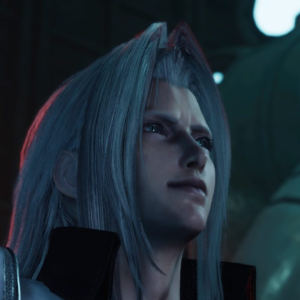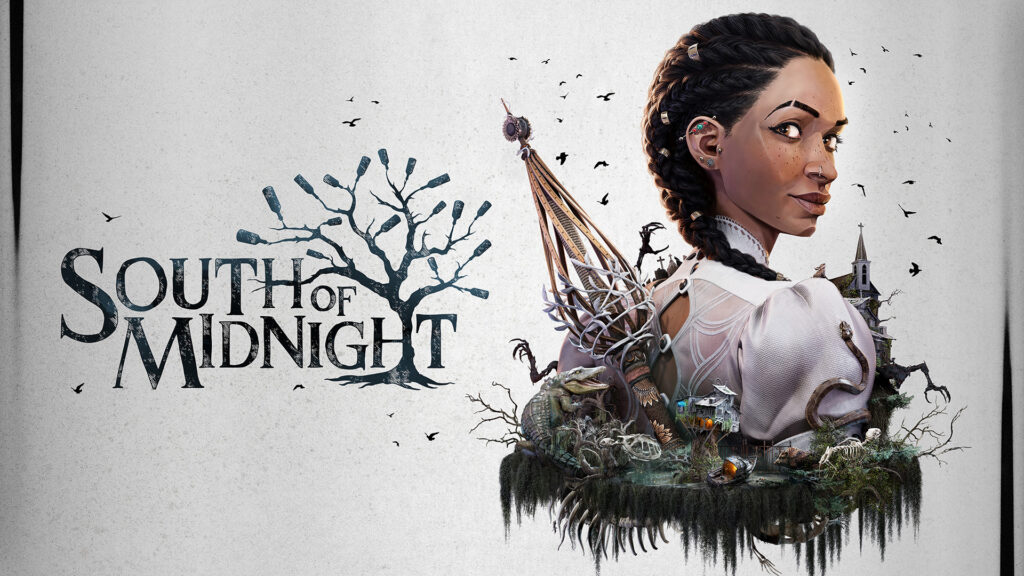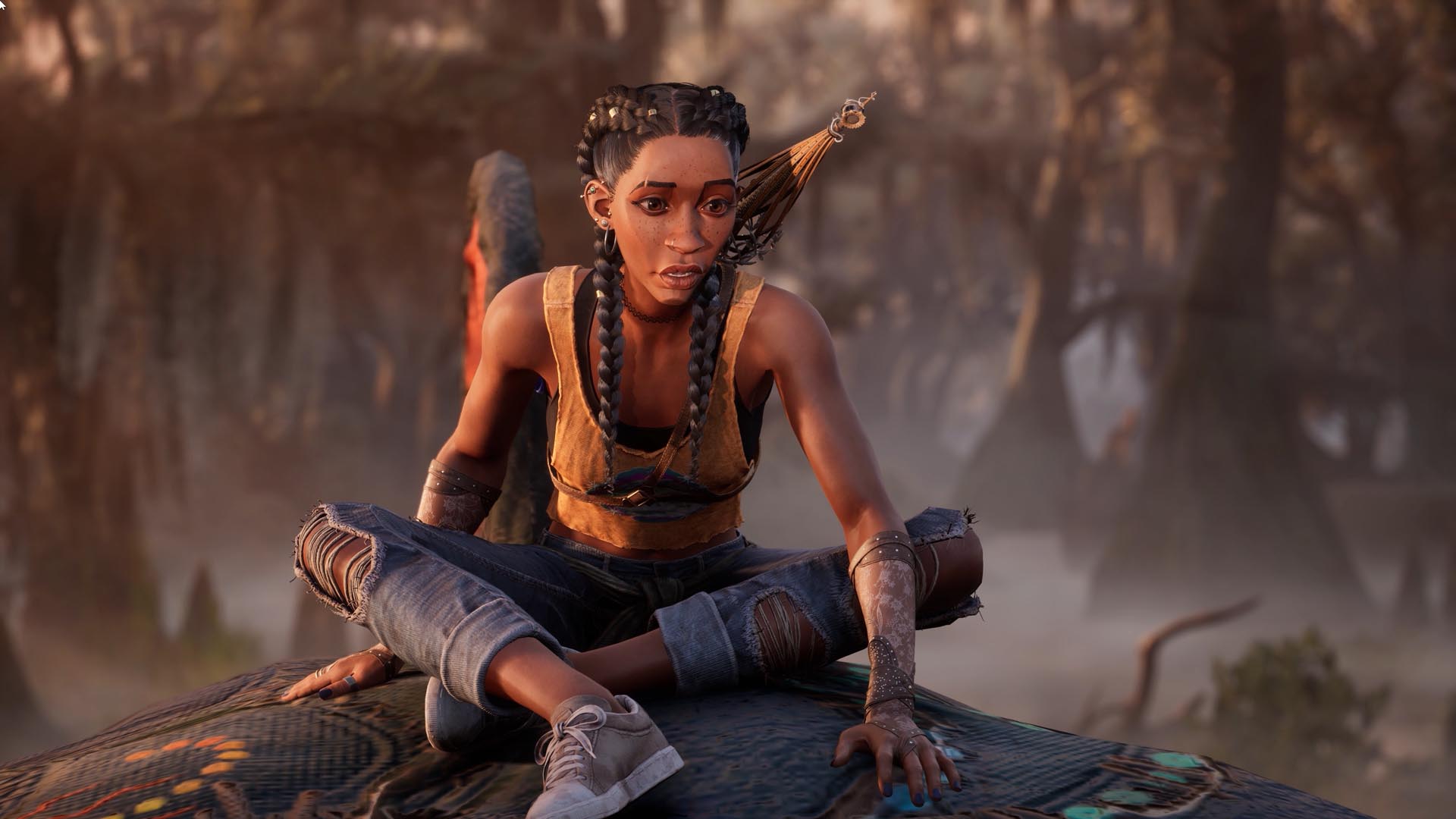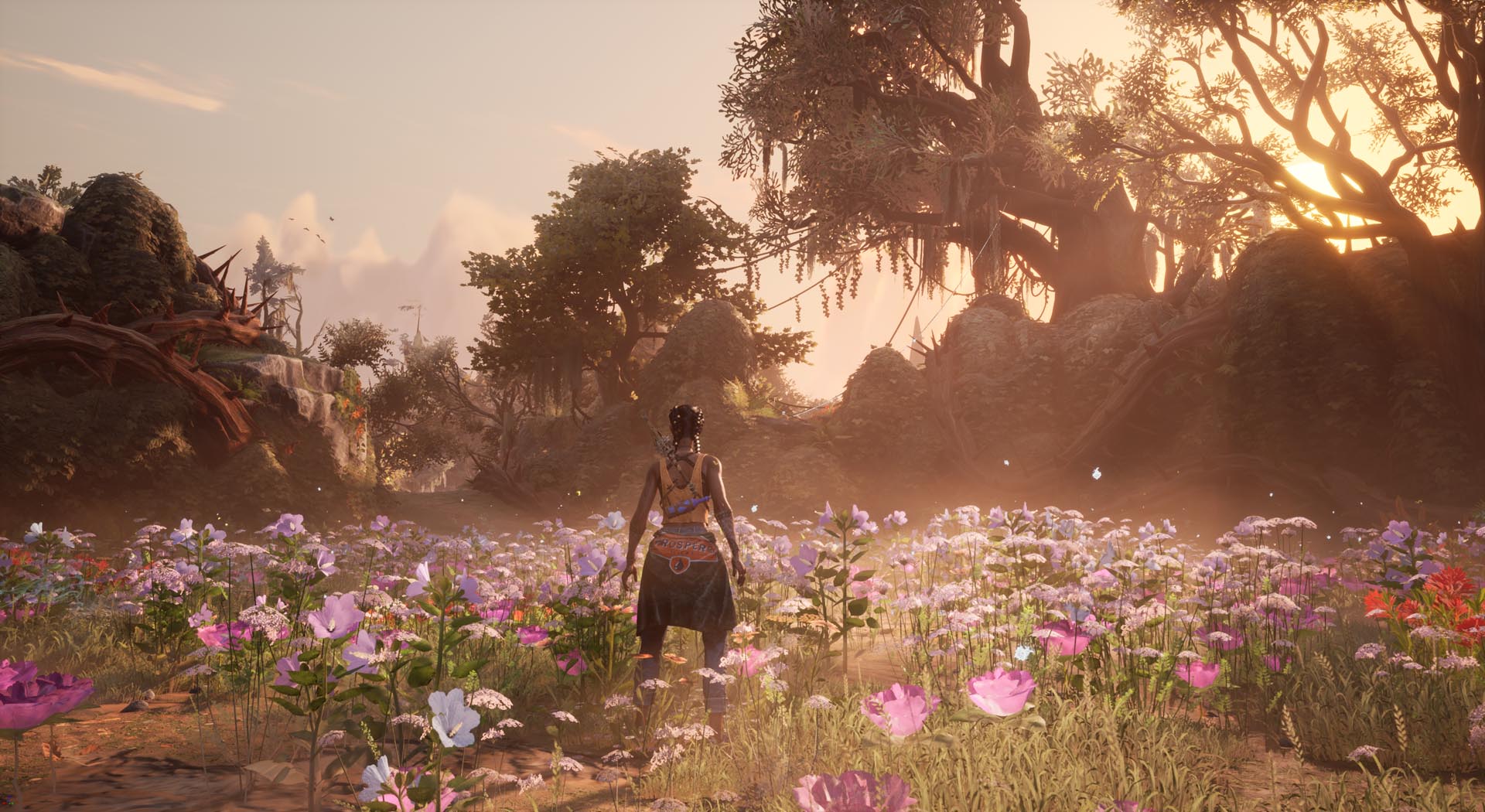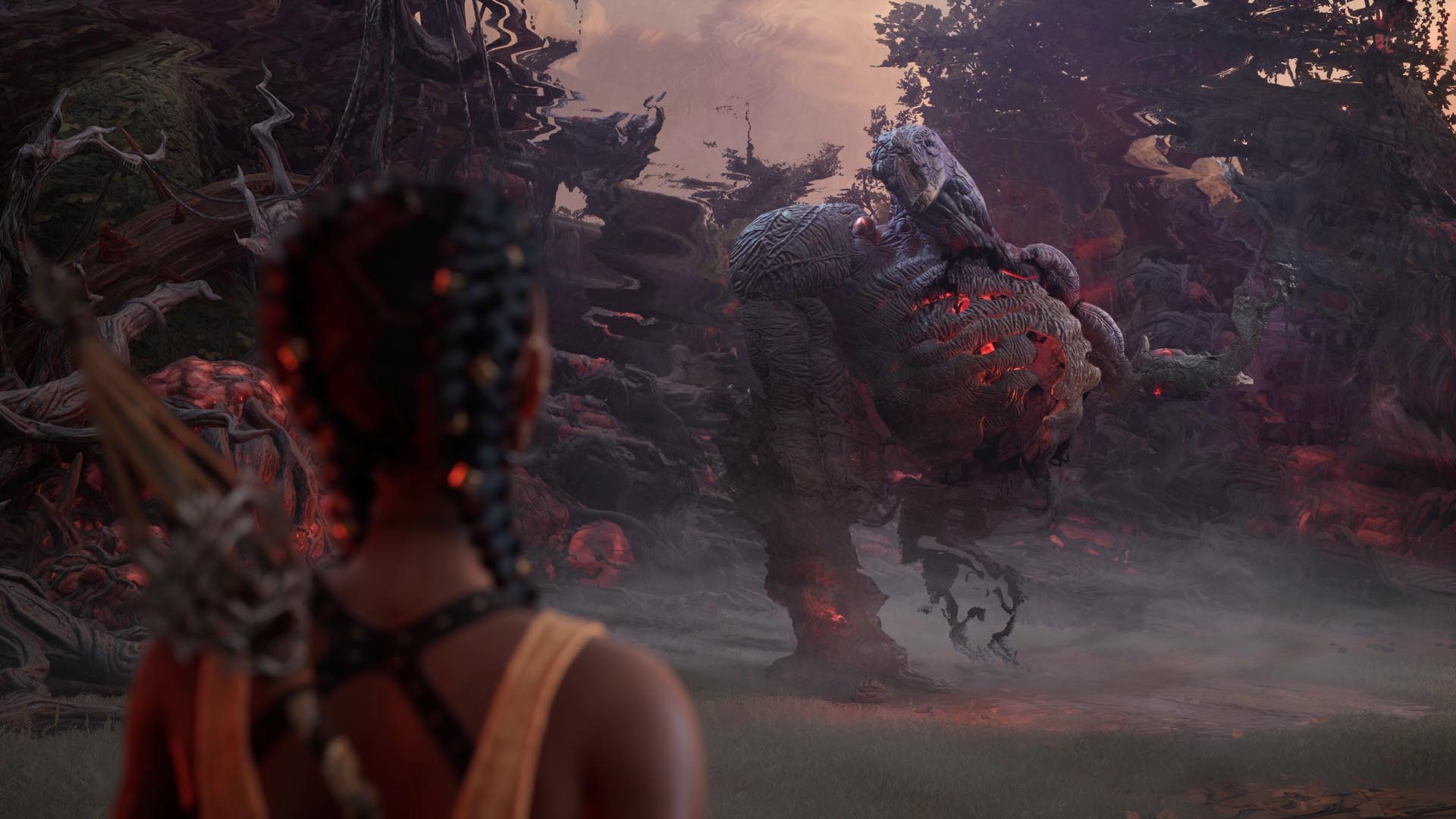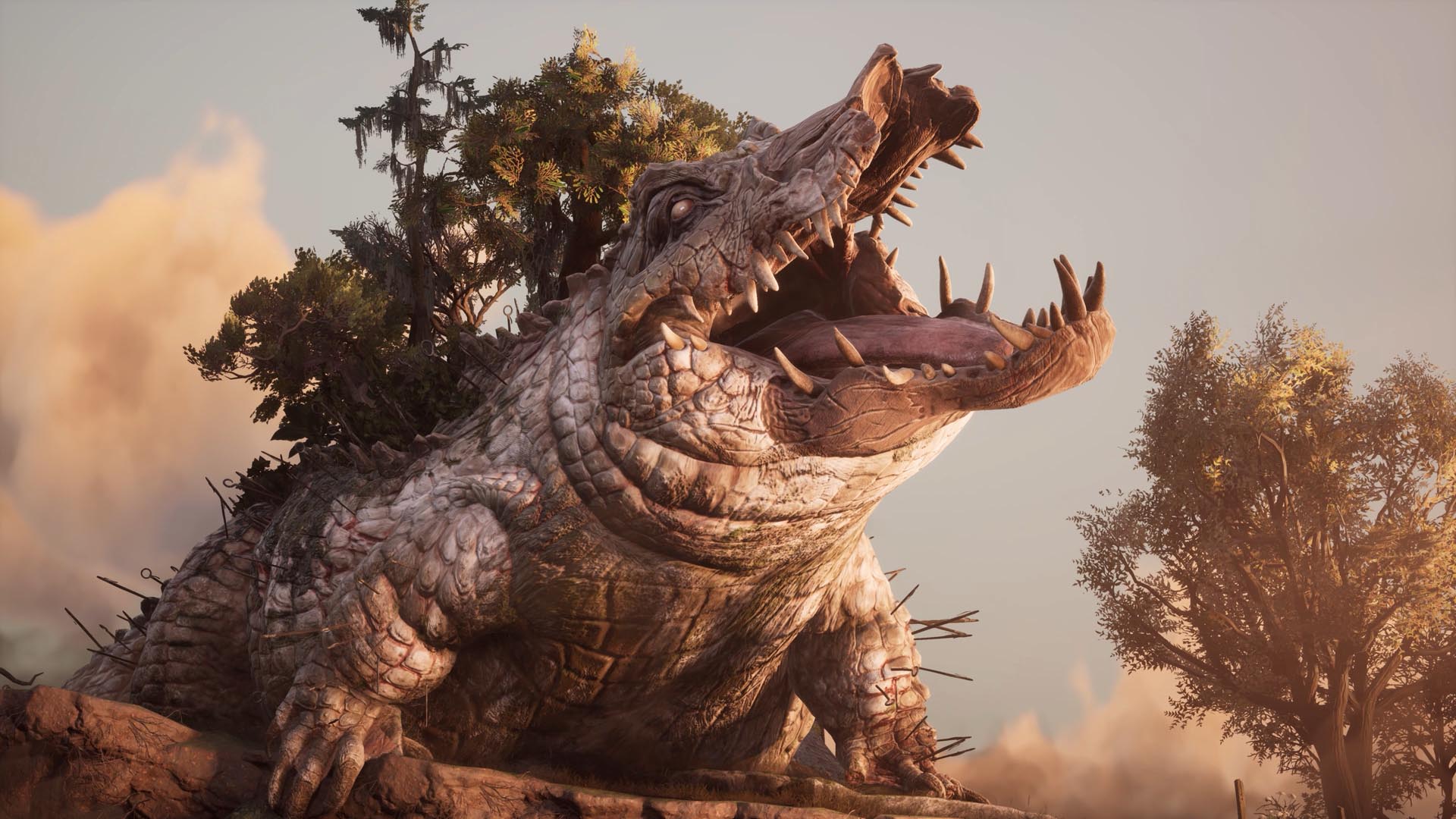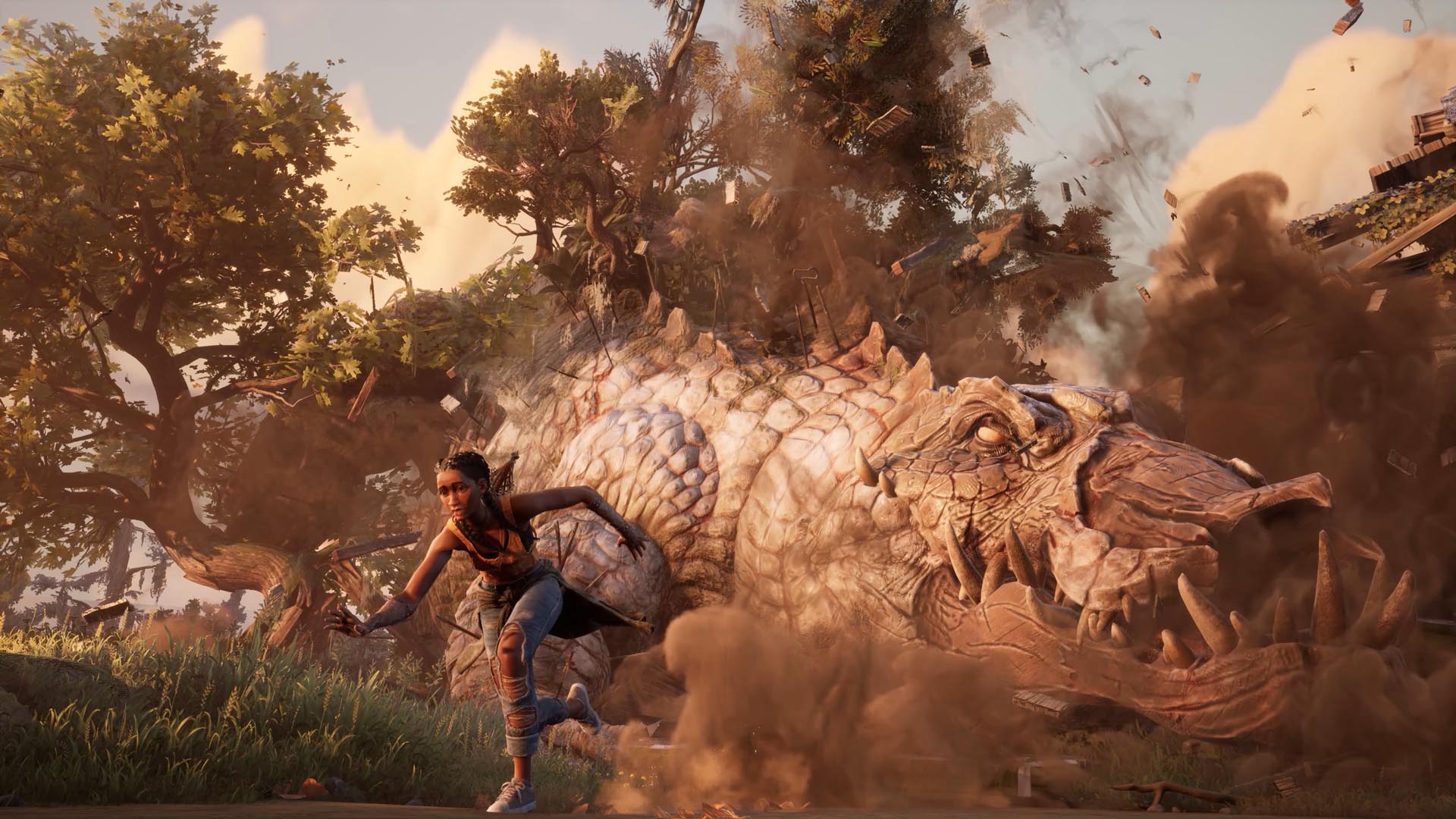“From top to bottom, that’s the message behind Hazel, her combat design, her powers,” Sears explains. “Everything is a Weaving metaphor – Weavers are supposed to put things right, do good in the world. She’s literally repairing the tapestry, and with creatures – Haints included – we spent a good amount of time making sure it was clear that when you’re attacking or interacting, you’re doing it in a non-lethal but aggressive way. You’re doing it because you’re helping – removing the weight of all this trauma.”
It might sound like a heady message, but the way this ties into the game is fundamental – and it’s what makes South of Midnight so unique. With such a clear goal in mind, it means that a game in a very familiar genre can feel wholly unfamiliar.
Take South of Midnight’s world, for a start. Compulsion describes the game as “wide-linear,” a series of distinct chapters, with a set beginning and end, but with opportunities to explore along the way:
“[Players] are really in control of traversing there,” explains Roy. “So the way we built the environment is because we want players to follow the narrative, but have more to sink their teeth into – you can sometimes see some more open, hub-like sections.” This is a world built to deliver Compulsion’s carefully crafted story, but with the opportunity to find currency or upgrades, or otherwise unseen vistas off the beaten path.
Each new region will come with its own biome, a reflection of the South’s wildly varied landscapes. All of those biomes are inspired by real-world locations – Sears won’t go into detail about the later game yet, but tells me that the section we see here is set as you’re about to exit the flood and enter Mississippi Delta-like countryside. However, the magical realist approach allows Compulsion to play with expectation as you travel through its world.
Locations will feel deeply rooted in what we know of the real world – in fact, to help create this section of the game, the developers took a trip to a real Mississippi ghost town, itself infested with alligators (only one of them braved the trek across amphibian territory to get into an abandoned church and take reference shots). But as we travel, we’ll see how these areas have become overtaken by the game’s mythical creatures, bringing twisted change with them.
‘The world Hazel comes from is inspired by the contemporary Deep South” says Clayton, “but as you dive deeper into the world, things become more mystical and surreal. We wanted the feeling that you’re being pulled into a folktale, rather than, say, crossing a barrier like in Alice in Wonderland.”
The Song of Tom
Of course, most folktales need antagonists and in the trailer we meet one of them. Two-Toed Tom is based on real-life campfire tales of ancient, giant, seemingly unkillable alligators, and he will – as Clayton puts it – “haunt” this chapter in Hazel’s tale. What we’ve seen are the very edges of his hunting grounds, but Tom will repeatedly reappear as you explore his region, eventually leading us to a showdown. It allows not just for a “boss fight” that effectively spans a whole section of the game, but also allows the team to turn each creature into a full-blown character, rather than a simple mechanism for conflict.
“Tom is the only mythical creature in the game who was not a human being before transforming,” explains Sears. “People transformed Tom – he was an alligator born with the will to live, and the will to eat, and those things seemed to work really well. Because, like a lot of reptiles, he will continue growing as long as he can eat. And because he has a traumatic backstory and has become a creature of folklore and urban legend, he’s going to persist and continue getting bigger and bigger.”
The idea, like everything else here, doesn’t seem to be that Hazel will kill the creatures standing in her way, more that she’ll be curing them, removing the hurt that turned them into monsters in the first place. And in perhaps the most starkly unexpected part of the trailer, we even hear the game’s music reflecting the story that made Tom what he is.
We heard last year that the game would reflect the regions of the Deep South through a shifting soundtrack, but this trailer reveals how far that goes – each mythical creature will have their own theme song. Composed by Olivier Deriviere (A Plague Tale: Requiem, Get Even), and with lyrics by Sears and the writing team, each song will be woven throughout the Kingdoms, growing in complexity and systemically responding to your actions, until full-blown lyrics begin telling the stories of the creatures you’re trying to evade and, eventually, cure. It’s rare to hear voiced songs in games – but it’s rarer to hear them originally composed to support the narrative throughout a whole game.
“I wanted the story of the origin of the creatures to be there,” says Sears. “If you had nowhere else to find it, you could listen to the whole track and it would tell you. It’s like a piece of the puzzle that you’ve collected in the history of the character.”
Striking With Purpose
Of course, setting and music are one thing, but combat and exploration are often more coldly mechanical pieces of game design – how do you ensure you’re still storytelling when you’re hammering buttons to take down a Haint or a boss?
Compulsion have utilised a few tricks here. For a start, it’s in how Hazel fights and gets around. Everything she can do is powered by her Weaving, and this links your actions intrinsically with that core goal of fixing what’s broken. To that end, it comes with a very neat bit of game design – while we see traversal powers (gliding using a Weaver sailcloth) and combat powers (like Unravelling enemies), Hazel will also gain a set of spells that show off Weaving’s utility. During the trailer, we can see three abilities available the top-left of the screen, and they come with some mechanical ingenuity:
“We don’t want to reveal everything in this particular gameplay trailer just yet,” says Roy, “[but] the spells are going to be used for traversal, problem solving, and combat. This is how Hazel expresses the use of her power, through the different gameplay elements.”
The powers we can see are Weave, Push, and Pull: Weave can be used to fix objects in place to help traversal, but will also bind enemies; Push and Pull can be used to move objects in the world to help solve puzzles, but also affect combat dynamics, letting you control enemy placement to an extent. You’ll unlock more as you go, all with this multifarious functionality. Turning your spells into something that can be used in any situation is a neat metaphor for how Hazel’s powers aren’t simply about destruction or survival.
Clayton explains that even how Weaving looks is an evocation of thinking differently. Magic in games so often takes in classical elemental ideas – fire, water, air, earth – but Weaving is an altogether separate visual idea.
“We needed to find something that connected to [the lore] and also have this Southern Gothic influence – this idea of taking back feminine crafts, and making them powerful, because we knew we wanted a female protagonist. That concept inspired this idea of a sort of living lace.”
The result is a game where the look is as powerful a part of the storytelling as the characters themselves – and the almost uncanny effect of how South of Midnight moves is a part of this, too. Last year’s trailer introduced us to Compulsion’s maquette-like designs, and stop-motion inspired animation, but seeing it as a working game is proof that the story trailer wasn’t just for show.
While the team has tweaked exactly how pronounced the effect is between cinematics, exploration, and combat, one of South of Midnight’s biggest differentiators from other games is in how committed the team has been to that look:
“We had to do a lot of testing, a lot of fiddling with dials,” says Clayton. “There’s a lot that goes into the stop-motion look – what can we get away with, and what just looks like a mistake? A lot of the game, from a visual standpoint, was reverse-engineering how people do things physically. The artists had to reverse-engineer building things from hand. And on the animation side, they were trying to mimic what happens when you do stop-motion animation.”
And here’s the most important point – Compulsion aren’t doing things differently simply to be different. There’s a guiding principle behind all this: Hazel’s story, the reflection of the Deep South, the real-life research that’s gone into it, and the myriad ways that storytelling leaks into every bit of design. This team believes in what they’re making, and has put thought into, well, everything.
As I speak to the developers, I realise that every element of the trailer I mention, even the smallest one, has a full backstory to it. From the tumorous walls that enclose a combat arena (it’s called Stigma, a physical manifestation of negative energy), to why there’s so much wildlife watching on (they represent the South’s persistent beauty), we spend minutes at a time discussing things you might otherwise never question. But they’ve questioned them, discussed them, and reasoned why they should be there.
South of Midnight feels as rich with storytelling as the age-old tales it draws on – and it promises to be like nothing we’ve ever played as a result.
South of Midnight will be released in 2025 on Xbox Series X|S, Windows PC, Steam, and Cloud – and play with Xbox Game Pass on day one.
